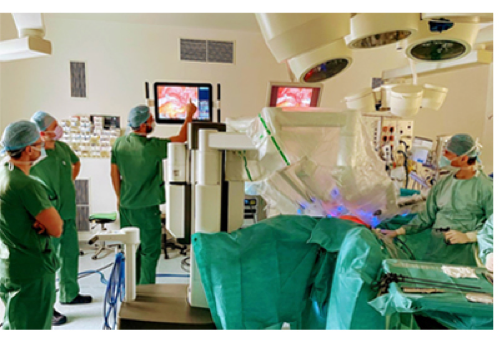Robotic Surgery In Gynaecology
Robotic surgery
The most modern and safe way to perform surgeries is robotically assisted laparoscopic surgery, known more widely as robotic surgery. Robotic surgery is coming to significantly change the surgical landscape by overcoming the limitations of the traditional laparoscopic technique.
It is impressive to point out that every 30 seconds a Da Vinci robotic operation is performed around the world. It is the first robotic system to be implemented on such a massive scale and is what most surgeons around the world have been trained on.

Laparoscopic surgery with the Da Vinci robotic system

The use of the Da Vinci® Xi robotic system contributes decisively to the provision of high-quality services. Its design enhances the capabilities of the surgeon as it provides him with 3D vision, image stability and enlargement of the surgical field thus providing him with the possibility of extremely delicate surgical manipulations. The surgeon controls tiny instruments with impressive precision and flexibility and thus, without large surgical incisions, is able to perform even complex surgical procedures using three to five small incisions (10 mm) in the abdomen.
By avoiding large incisions we minimize pain, hospital stay and recovery time.
For most women, robotic surgery in gynecology offers numerous benefits over open procedures such as:
- Less pain;
- Safer surgeries with less blood loss;
- Lower chance of infection and post-operative complications;
- Shorter hospital stay (usually one night);
- Faster recovery and return to work;
- Perfect aesthetic result.
Robotic surgery in gynaecology also offers benefits and solutions in areas such as:
Patients with increased body weight: robotic surgery makes it technically possible to perform complex operations without large incisions in women with an increased body mass index.
Infertility: the precision of surgical movements in robotic surgery allows operations close to important structures such as the endometrium, fallopian tubes and ovaries without threatening their integrity. At the same time, the suturing and restoration of the structures is done with a better anatomical relationship, which contributes to the correction of infertility problems.
Oncology: the stability of movements offered by the ergonomics of minimally invasive surgery tools ensures the safety of the oncological result. The vast majority of gynaecological procedures can be performed with robotic surgery.
More specifically, common gynaecological conditions include:
- Dysfunctional uterine bleeding;
- Fibroids;
- Endometrial cancer / uterine cancer;
- Endometriosis;
- Pelvic organ prolapse.
Treatment of gynaecological cancer
In particular in the field of gynaecological cancer, the use of robotic surgery has radically changed the surgical treatment of the disease, especially endometrial and cervical cancer.
These operations include in the majority of cases a total hysterectomy after the appendages and an extensive pelvic lymphadenectomy (removal of lymph nodes from the pelvis) or removal of a sentinel lymph node.
We can precisely find that lymph node most likely to have metastatic disease and avoid major lymphadenectomies and their complications.
The improved and at the same time safe oncological outcome is what makes robotic surgery worldwide the operation of choice for gynaecological endometrial and cervical cancer. International guidelines suggest, where possible, in gynaecological endometrial cancer, to follow the minimally invasive approach, confirming the superiority and safety of this technique.
The vast majority of gynaecological procedures can be performed with robotic surgery.
Fertility improvement operations
Robotic surgery can deal with more detailed and precise manipulations of elements of genital pathology. Faithful restoration of surgical structures increases fertility, while causing far fewer adhesions. In this way, robotic surgery is the ideal way to treat endometriosis, but also operations aimed at improving the fertility of infertile couples, such as the removal of fibroids and ovarian cysts.
The doctor
Dr. Nikolaos Plevris, has been recognized as a Certified Surgeon and Trainer for gynaecological operations in the robotic surgical system of the company "Da Vinci". He actively participates in the Training of Educational Programs in gynecology, in Southeastern European countries.
First Gynaecological robotic operation in Hungary, at the National Institute of Oncology

Under the supervision of Dr. Plevris, four robotic gynecologic cancer surgeries were performed at the National Oncology Institute. In all operations, the sentinel lymph node technique was used to identify metastatic disease.
In this context, the first robotically assisted hysterectomy in Hungary was performed together with the highly experienced gynecologists
Dr. Nikolaos Plevris, operates with the Da Vinci® Xi robotic system also in Cyprus, at Apollonion Private Hospital which now belongs to the large family of Hellenic Health Care Group, the largest private group providing health services in Greece.

Written by Nikolaos Plevris
Obstetrician - Surgeon - Gynaecologist
Director of the 1st Gynaecological Clinic Metropolitan General
